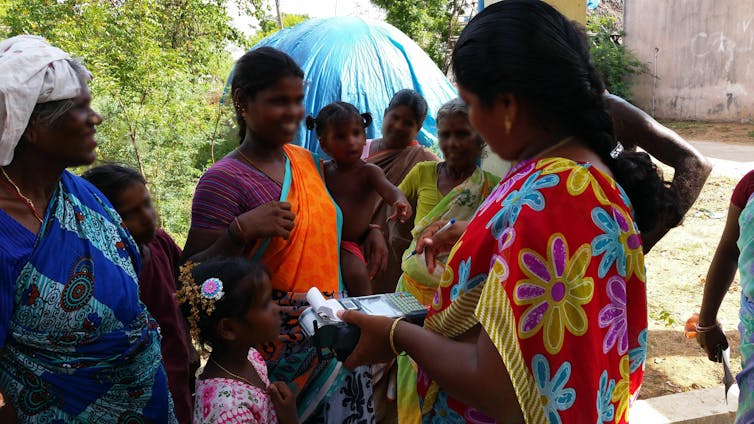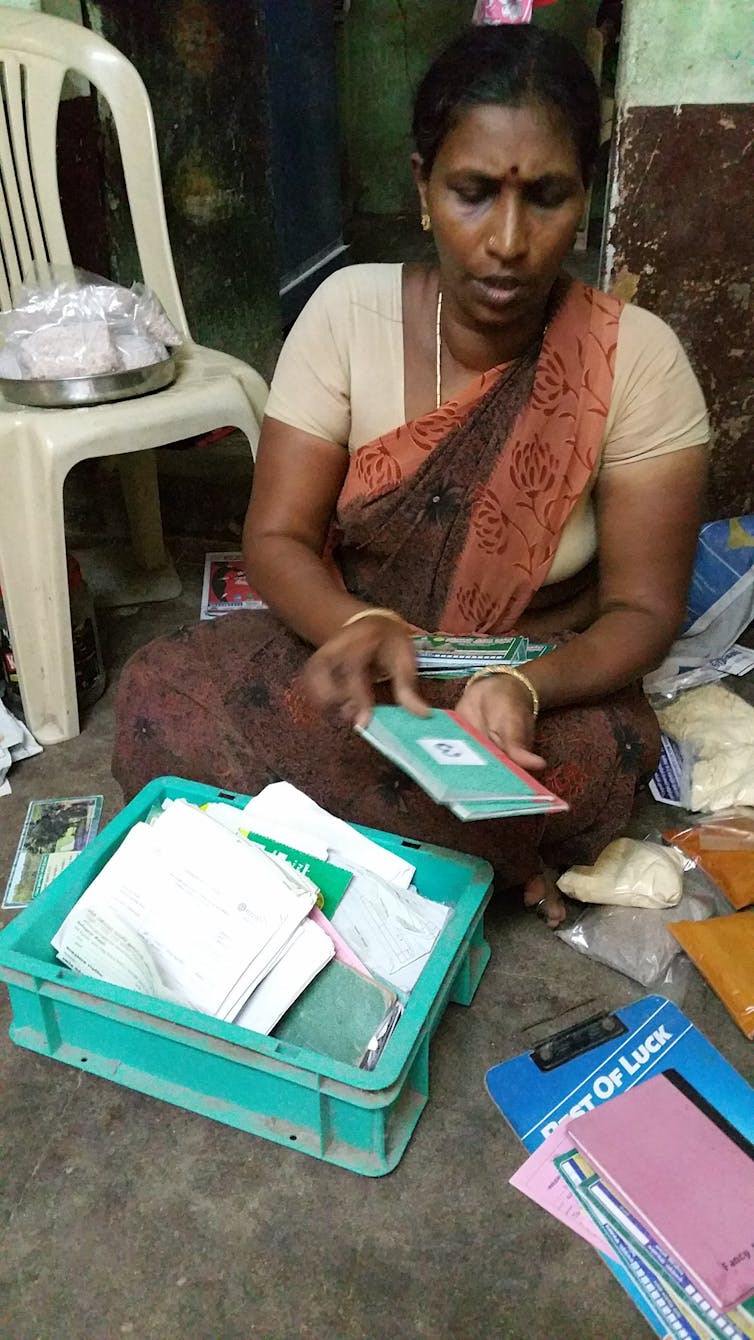“I spend my time managing and racking up debt. How do you expect me to work?” (Pushpurani)
A Dalit woman (formerly untouchable) from a village in Tamil Nadu (India), Pushpurani is constantly juggling ten to twenty loans, taken out with finance companies, informal moneylenders, the local elite and neighbours.
“Why do so many retired people go back to work? Because of debt” (Felipe, resident of a favela in Vitoria, Brazil).
Felipe’s mother, Dona Gê, 74, has been making clothes and selling cakes on the street ever since repayment of her loans took up 70% of her retirement pension.
These testimonies illustrate the concrete repercussions for working-class women of a global trend observed over the last three decades: the explosion in household debt, driven by increased access to credit and heightened economic vulnerability.
In different parts of the world, managing debt on a day-to-day basis is a real form of work, and this “debt work” is carried out primarily by women. Finding the funds to repay the debt then leads to new forms of work, “work for the debt”, which again often affects women.
Work on and for the debt is emerging as a new form of unpaid shadow labour, symptomatic of financialised economies. Two recent doctoral dissertations, one in economics, the other in socio-anthropology, and a forthcoming book give an account of this reality in India and Brazil.
The scale of debt
While household debt remains highly uneven from one country to another, its average level almost doubled between 1995 and 2021 in OECD countries, rising from 68% to 127% of disposable income (OECD, 2023. The acceleration is particularly evident in the South. According to the BIS, household debt will jump from 28 to 50% of GDP in emerging economies between 2010 and 2022.
But while in the North property loans account for the bulk of indebtedness (84% in France in 2021), its growth in the South is mainly driven by various forms of consumer credit, which so-called financial inclusion policies have democratised since the 2000s, targeting working-class people and women in particular.
In Brazil, according to data from the Central Bank, the proportion of households indebted to credit institutions rose from 44% to 55% between 2010 and 2015, before climbing during the Covid-19 pandemic to reach 80% by 2021.
In Tamil Nadu, following two decades of banking policies and the development of women’s microcredit, rural survey data from the Observatory of Rural Dynamics and Inequality in South India document an increase in average household debt from 160% to 250% of annual income between 2010 and 2016. And debt weighs more heavily on women, who earn on average 22% of household income but shoulder 37% of debt.

The vast majority of these are aimed at “making ends meet”: food, healthcare, housing, water, gas and electricity bills. They also make it possible to take part in rituals, buy consumer goods… and pay off other debts.
In this respect, while microcredit has long been thought of as a way of helping people to set up their own business and escape poverty, it has turned out to be primarily a form of consumer credit, at best smoothing out income and expenditure over time, and at worst acting as a factor in over-indebtedness.
Debt work
Working-class women are at the forefront of the new forms of labour generated by this increased use of finance. As managers of family budgets, they find themselves monopolised by the management and refinancing of debts, not only those contracted in their own name but often those of the family as a whole.
In the French context, the ethnographies of Ana Perrin-Heredia and Camille François clearly show that women manage shortfalls and overdrafts and are the first targets of bailiffs when it comes to being behind on rent.
Managing debt is real work: the tasks are routine, time-consuming and require very specific skills. In Tamil Nadu, for example, this “debt work” involves handling monthly, weekly and even daily repayment transactions. It involves juggling five, ten, fifteen loans at a time, and keeping track of these skeins of debt through incessant mental gymnastics, which require complex calculations based on price and sentiment criteria.

Amounts, prices and repayment terms also have to be negotiated with a wide range of lenders, in order to adapt them to the irregularity and unpredictability of income. In addition to microcredit organisations and finance companies, loans come from a myriad of lenders in the neighbourhood or neighbouring towns, including pawnbrokers, itinerant moneylenders, shopkeepers, the local elite, friends, neighbours and relatives.
Dealing with debt also means having to deal with derogatory or contemptuous remarks from moneylenders, and sometimes insults, while keeping calm. Not honouring your debt is a sign of irresponsibility, frivolity and poor management, and prevents you from getting into debt again. For lenders, whatever their profile, sullying reputations is a formidable weapon for encouraging repayment.
Finally, you need to take care of your appearance and attitude, to come across as a strong, determined woman who is capable of repaying her debts. And if material means are lacking, it’s a case of monetising your body and entering into a myriad of debt-sex exchanges, from smiling and touching to penetration.
Working for debt
Debt work often goes hand in hand with work for debt, aimed at finding the funds needed to pay debts and interest that are often exorbitant. In Brazilian favelas, this means longer working days, extending into evenings and Sundays. People juggle two or three activities to keep the cash flowing in. For the men, it’s mainly a case of working on building sites in degraded conditions, with no social protection and for less than the legal minimum wage.

For women, this may mean working outside the home, as a cleaner, or in the home, making clothes or cakes that are then sold at the market. This is particularly the case for grandmothers, who continue to work after retirement and use their access to credit to help their unemployed children.
Debt work and work for debt represent an immense source of dispossession for the working classes and profit for the financial industry, which relies on the free labour of women as well as on the capture of a considerable share of family income: the share of interest represents 30% in Tamil Nadu in 2016 according to the survey cited above, 12% in Brazil in 2021.

However, this exploitation cannot be reduced to financial predation. It is rooted in a system of accumulation that is incapable of ensuring the social reproduction of workers, combining the inability of private capital to provide subsistence wages with the inefficiency of the state to provide real social protection.
Women’s resistance
These characteristics can be found in Europe, albeit in more subtle and varied forms. In France, pension reforms and reforms to reduce the “cost of labour”, carried out against a backdrop of budgetary austerity, are making it harder for working-class people to “make ends meet”. Faced with these growing constraints, the “yellow vest” movement has highlighted the central role played by mothers in debt management (particularly bills and mortgages). These mobilisations also show that the “work of debt” is the support of women’s resistance and a political voice, rooted in the everyday lives of working-class people.
For while women are shadowy players in finance, they are also fervent opponents. In Argentina, in various [European] countries(https://www.lepassagerclandestin.fr/catalogue/essais/nos-vies-valent-plus-que-leurs-credits/), but also in Morocco, in Sri-Lanka, in India, and probably elsewhere, they are speaking out against the violence of debt and its excessive weight on their shoulders. These women are actively campaigning for the debt to be cancelled, but also for social policies to avoid this chronic indebtedness. It’s time to listen to them.
Les auteurs ne travaillent pas, ne conseillent pas, ne possèdent pas de parts, ne reçoivent pas de fonds d'une organisation qui pourrait tirer profit de cet article, et n'ont déclaré aucune autre affiliation que leur organisme de recherche.
This article was originally published on The Conversation. Read the original article.







